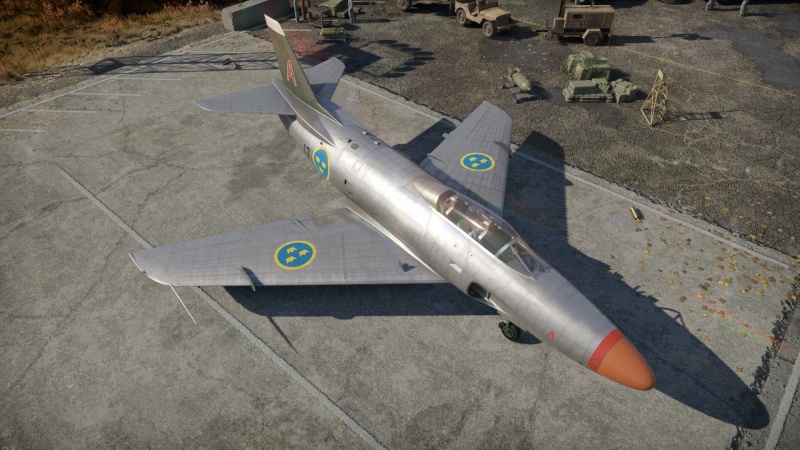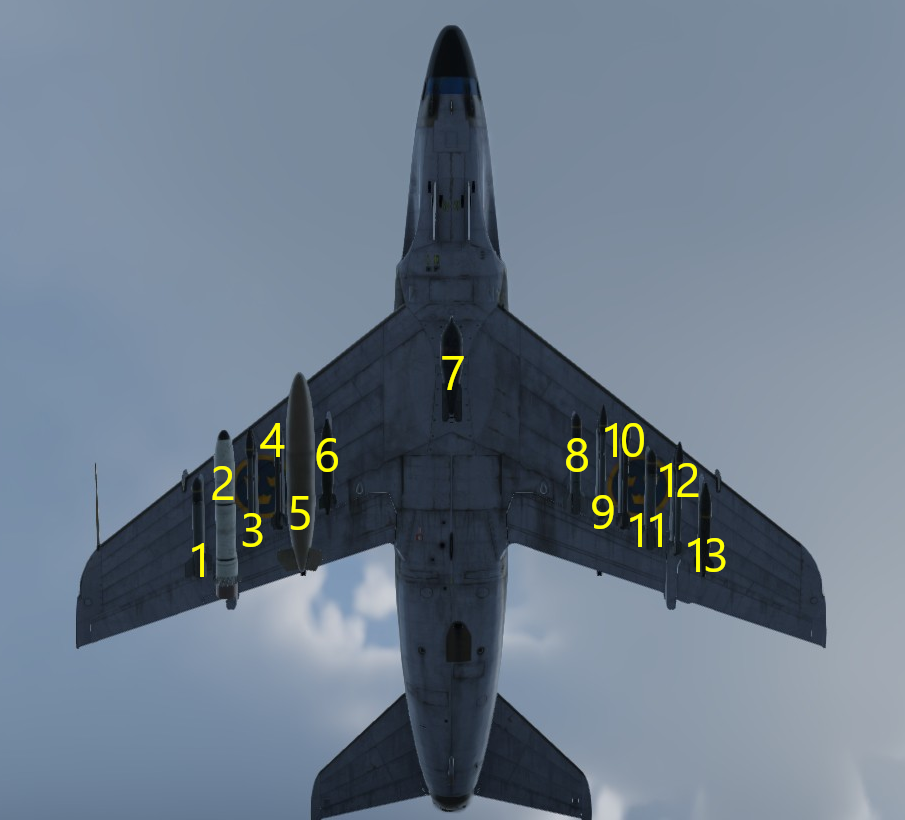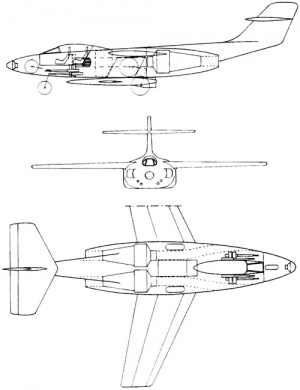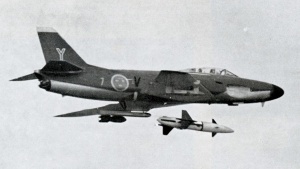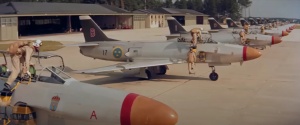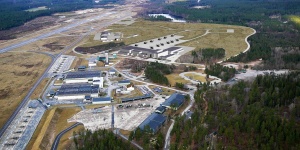Difference between revisions of "A32A Röd Adam"
TunderTunder (talk | contribs) (Tag: Visual edit) |
TunderTunder (talk | contribs) (Tag: Visual edit) |
||
| Line 195: | Line 195: | ||
|} | |} | ||
| − | + | For pilots are available: | |
| − | |||
'''Bombs:''' | '''Bombs:''' | ||
| Line 206: | Line 205: | ||
* 3 x 500-kg Brandbomb m/58 incendiary tanks - useless against armored vehicles, and one base requires as many as four discharges, besides, the incendiary mixture extinguishes very quickly before it can cause significant damage. | * 3 x 500-kg Brandbomb m/58 incendiary tanks - useless against armored vehicles, and one base requires as many as four discharges, besides, the incendiary mixture extinguishes very quickly before it can cause significant damage. | ||
| − | ''' | + | '''Rockets:''' |
* 24 x 14.5 cm psrak m/49B rockets - shaped charge rockets with 500 mm penetration, most effective against enemy armored vehicles, but requires accuracy or multiple hits - difficulty is the location of rockets along the wings; | * 24 x 14.5 cm psrak m/49B rockets - shaped charge rockets with 500 mm penetration, most effective against enemy armored vehicles, but requires accuracy or multiple hits - difficulty is the location of rockets along the wings; | ||
Revision as of 12:07, 12 August 2024
| This page is about the premium Swedish strike aircraft A32A Röd Adam. For other versions, see SAAB 32 Lansen (Family). |
Contents
Description
The A32A «Röd Adam» is a premium rank VI Swedish strike aircraft with a battle rating of 9.0 (AB/RB/SB). It was introduced in Update "Sons of Attila".
General info
Flight performance
The aircraft is powered by a Svenska Flygmotor RM5A turbojet engine, a licensed version of the British Rolls-Royce Avon Mk 21A TRD. The engine develops 3,420 kgf in normal operation and 4,630 kgf on afterburner, a very mediocre performance for such a large attack aircraft. With a full bomb load the airplane barely breaks away from the runway surface and cannot accelerate above 780 km/h. Even after jettisoning the suspended armament, the maximum speed increases to only 1050 km/h. In addition, at high altitudes, engine efficiency is significantly reduced, so do not try to climb above three kilometers - most of the opponents will be much higher anyway. It is better to gain maximum speed near the ground and then spend it as sparingly as possible, and in no case try to run away from the opponents at altitude. Needless to say, almost any potential opponent will be much faster than the Swedish Striker.
The aircraft's arrow-shaped wing has a large area and advanced mechanization, which means low stall speed and good stability at low speeds. Also a large area of ailerons as if disposes to active maneuvering, but let down the stabilizer - it loses its effectiveness at speeds above 600 km / h and does not allow you to conduct active maneuvering. But, thanks to limited rudder thrust and competent centering, the aircraft almost never reaches critical angles of attack, as, for example, Mig-21 or J35D. Because of this, and the low aerodynamic drag of the airframe, the airplane keeps energy very well. This feature can allow you to roll over opponents who have lost energy, and in case of failure, quickly retreat before the enemy has time to regain speed.
As a result, when playing the A32A, you should not rely on the aircraft's LTX. After all, the priority for an attack aircraft is armament, and here it is really good.
| Characteristics | Max speed (km/h at 0 m - sea level) |
Max altitude (metres) |
Turn time (seconds) |
Rate of climb (metres/second) |
Take-off run (metres) | |||
|---|---|---|---|---|---|---|---|---|
| AB | RB | AB | RB | AB | RB | |||
| Stock | 1,088 | 1,084 | 12500 | 34.6 | 35.6 | 44.7 | 41.8 | 900 |
| Upgraded | 1,101 | 1,094 | 33.6 | 34.0 | 66.2 | 55.0 | ||
Details
| Features | |||||
|---|---|---|---|---|---|
| Combat flaps | Take-off flaps | Landing flaps | Air brakes | Arrestor gear | Drogue chute |
| ✓ | ✓ | ✓ | ✓ | X | X |
| Limits | ||||||
|---|---|---|---|---|---|---|
| Wings (km/h) | Gear (km/h) | Flaps (km/h) | Max Static G | |||
| Combat | Take-off | Landing | + | - | ||
| 1160 | 450 | 524 | 491 | 320 | ~11 | ~5 |
| Optimal velocities (km/h) | |||
|---|---|---|---|
| Ailerons | Rudder | Elevators | Radiator |
| < 850 | < 600 | < 600 | - |
Engine performance
| Engine | Aircraft mass | ||||||
|---|---|---|---|---|---|---|---|
| Engine name | Number | Basic mass | Wing loading (full fuel) | ||||
| Svenska Flygmotor RM5A | 1 | 8,322 kg | 294 kg/m2 | ||||
| Engine characteristics | Mass with fuel (no weapons load) | Max Gross Weight | |||||
| Weight (each) | Type | 13m fuel | 20m fuel | 30m fuel | 44m fuel | ||
| 1,350 kg | Afterburning axial-flow turbojet | 9,151 kg | 9,568 kg | 10,191 kg | 11,084 kg | 12,992 kg | |
| Maximum engine thrust @ 0 m (RB/SB) | Thrust to weight ratio @ 0 m (WEP) | ||||||
| Condition | 100% | WEP | 13m fuel | 20m fuel | 30m fuel | 44m fuel | MGW |
| Stationary | 3,424 kgf | 4,633 kgf | 0.51 | 0.48 | 0.45 | 0.42 | 0.36 |
| Optimal | 3,424 kgf (0 km/h) |
4,908 kgf (1,160 km/h) |
0.54 | 0.51 | 0.48 | 0.44 | 0.38 |
Survivability and armour
The airframe itself does not have a high survivability: the airplane, of course, can survive a machine-gun burst or a couple of hits from a soviet 23-mm cannon, but no more than that. The spars in the wings are quite fragile and are destroyed by several hits from air cannons and strong negative overloads. The minus is also large dimensions, which greatly simplify the enemy shooting at the machine.
In the fuselage and wings are installed treaded fuel tanks, which are quite rarely set on fire. Two pilots, fire suppression system and blocks of dipole reflectors also contribute to the survivability of the aircraft. The cockpit is protected by 5 to 15 mm thick armor, as well as 50 mm armored glass, but this protection is enough for a few fragmentation shells, and armor-piercing 12.7- and 20-mm shells will easily penetrate this armor.
A32A armor scheme
On the A32A it is definitely not worth taking risks - any damage to the control surfaces or internal components of the machine immediately affects the controllability and control of the aircraft, which forces to withdraw from the battle and return to the airfield.
Modifications and economy
Armaments
| Ballistic Computer | |||
|---|---|---|---|
| CCIP (Guns) | CCIP (Rockets) | CCIP (Bombs) | CCRP (Bombs) |
| |
|
|
|
Offensive armament
The A32A Röd Adam is armed with:
4x 20mm Akan m/49 cannons, which are a development of the Akan m/45, are mounted in the nose of the airplane. The cannons have a good rate of fire of 770 rounds per minute and a total ammunition capacity of 720 rounds, 180 per barrel. The cannon shells have good ballistics and low dispersion, which allows for effective fire at ranges up to 900 meters, but insufficient damage does not allow to shoot down planes from several hits, forcing to shoot long bursts.
The following ribbons are available for the Akan m/49:
Standard - a mixed tape, not bad against both air and ground vehicles;
Ground targets - the tape is ineffective against aerial targets, and 38 mm armor-piercing shell penetration will not be enough to destroy armored vehicles;
Air targets - the most preferred tape against enemy aircraft and lightly armored SAMs. The high-explosive shells are very effectively “sawing” planes, while the armor-piercing shells can easily deal with various lightly armored IFVs, BMPs or light tanks.
Suspended armament
As is typical of attackers, the aircraft has a fairly wide selection of suspended armament, and the presence of a ballistic computer greatly simplifies the attack and increases the overall effectiveness of the aircraft.
| 1 | 2 | 3 | 4 | 5 | 6 | 7 | 8 | 9 | 10 | 11 | 12 | 13 | ||
|---|---|---|---|---|---|---|---|---|---|---|---|---|---|---|
| 120 kg sb m/61 bombs | 1 | 1 | 1 | 1 | 1 | 1 | 1 | 1 | 1 | 1 | 1 | 1 | ||
| 250 kg mb m/50 bombs | 1 | 1 | 1 | 1 | 1 | |||||||||
| 500 kg mb m/56 bombs | 1 | 1 | 1 | |||||||||||
| 600 kg mb m/50 bombs | 1 | 1 | 1 | |||||||||||
| Brandbomb m/58 incendiary bombs | 1 | 1 | 1 | |||||||||||
| hprak m/49 rockets | 1 | 1 | 1 | 1 | 1 | 1 | 1 | 1 | 1 | 1 | 1 | 1 | ||
| psrak m/49B rockets | 2 | 2 | 2 | 2 | 2 | 2 | 2 | 2 | 2 | 2 | 2 | 2 | ||
| srak m/51 rockets | 2 | 2 | 2 | 2 | 2 | 2 | 2 | 2 | 2 | 2 | 2 | 2 | ||
| Chaff | 16 | 16 | ||||||||||||
| Maximum permissible loadout weight: 1,850 kg | ||||||||||||||
For pilots are available:
Bombs:
- 12 x 120-kg mb m/61 bombs - almost useless for hitting moving targets, requires jewel-like precision from the pilot;
- 5 x 250-kg mb m/50 bombs - a set for skillful pilots who are able to throw bombs as accurately and close to targets as possible.
- 3 x 500-kg mb m/56 bombs - not recommended due to the lower explosive quantity compared to the 600-kg m/50, while the same number of bombs can be hung on the aircraft;
- 3 x 600-kg mb m/50 bombs - a bomb that has proven itself on the B18B and A21A-3 due to its impressive TNT equivalent and large kill radius. It is excellent at destroying bases and concentrations of ground vehicles;
- 3 x 500-kg Brandbomb m/58 incendiary tanks - useless against armored vehicles, and one base requires as many as four discharges, besides, the incendiary mixture extinguishes very quickly before it can cause significant damage.
Rockets:
- 24 x 14.5 cm psrak m/49B rockets - shaped charge rockets with 500 mm penetration, most effective against enemy armored vehicles, but requires accuracy or multiple hits - difficulty is the location of rockets along the wings;
- 24 x 15 cm srak m/51 rockets - high-explosive rockets with 4.5 kg of TNT. Almost useless against all armored vehicles with closed fighting compartment;
- 12 x 18 cm hprak m/49 rockets - slightly more powerful high-explosive rockets with 5,25 kg TNT. To destroy an enemy tank you need to hit exactly the roof of the turret or hull.
For air battles it is recommended to take three 600-kg bombs - enough to destroy one base. For ground battles, you can take 5 x 250-kg bombs - that's five potential kills, or load three 600-kg bombs - cheap and angry. From unguided rockets it is worth taking shaped m/49B - they can penetrate any armor on these combat ratings, and the overpressure will destroy open vehicles with one hit.
Usage in battles
In air realisic battles
In ARB you can take three 600 kg bombs - their total TNT equivalent is enough to destroy one base. Also take fuel for 30 minutes of flight, because most of the time you will have to fly with the afterburner on. After dropping bombs, you can return to the airfield, or try your luck against enemy aircraft. In this case, the use of the airplane is very similar to the use of early reagents - you have to rely on the gained energy and speed, and do not get involved in "dogfights". Just get enough speed and look for inattentive or energy-depleted opponents. The airplane is very good at conserving energy, so you'll have a good chance even against sluggish opponents like Sabres and early MiG-21s, as long as you always leave yourself time to retreat. Don't be greedy and don't underestimate the enemy - if you let the enemy pass you forward due to your own negligence, you won't be able to throw him off your tail. Even if you are far away from the enemy, it does not mean that you are safe. It is very likely that a missile will be fired at you, so it is worth looking around regularly.
In ground realistic battles
In GRB, the airplane reveals its best side. Powerful suspended armament and ballistic calculator allow you to destroy several targets in one run and hide from enemy SAMs. Due to the airborne appearance, thrust problems are negligible, and closer to the tank battlefield you will have a very good reserve of speed and energy.
When selecting a suspended weapon, it is important to understand the situation on and above the battlefield. If there are enemy planes in the sky and SAMs on the ground, then take 3 x 600-kg m/50s - you can quickly drop them and move back to safe lines. If there is no threat from air and ground, or you are a battle-hardened pilot, take 5 x 250-kg bombs. They require an accurate hit near the tank, but that's five potential "frags". After the first run, don't rush to turn around and build a second run - you'll lose all speed, and the weak engine won't allow you to get it back quickly. It is better to just fly around the tank map from the side where you are not expected and strike again.
In simulator battles
In EC, the airplane using as an attack aircraft. It destroys bases, bombs convoys and doing CAS. Due to its poor flight performance, the airplane has no anti-air potential in this mode. In ground simulation battles, the A32A get into two main setups:
In the first set-up, you will be threatened by SAMs with radar: ZSU-23-4 and ZSU-37-2. Dipole reflector blocks are good against them.
In the second set-up the enemy team will be equipped with SAMs, such as Strela-10M2 and 2S6, and the sky will be dominated by MiG-21SMT, F-5A and Su-25.
And if in the first case you can somehow fight with the enemy armored vehicles avoiding enemy radars and SAM fire, then in the second case the outdated subsonic attack aircraft will have no chance against enemy SAMs and SPAAs.
Pros and cons
Pros:
- Good handling and stability at low speeds
- High kinetic energy efficiency
- Large payload of 1.5 tons
- Wide range of outboard weapons
- Ballistic computer
- Large ammunition for offensive armament
- Presence of chaff that prevent lock by enemy radars
Cons:
- Low thrust capability
- Poor maneuverability
- Fragile wing spars
- Large size
- Lack of guided weapons, especially air-to-air missiles
- No LTC to counter enemy infrared sensors
History
In 1946, the Royal Swedish Air Force formulated requirements for a two-seat all-weather attack aircraft, carrying powerful directional weapons, free-fall bombs, HVARs, and capable of reaching any point on the Swedish coast within one hour. Saab immediately began work on the project, which was designated P.1150.
Initially the aircraft was planned to use two engines, but due to the technical and operational problems of such a layout, it was decided to use a more mature, single-engine scheme. The engine of choice was the domestic RM4 produced by STAL. But problems with the development and start of its production forced the company to ask the British government to purchase a license for the Rolls-Royce Avon engine, which was frankly better than its Swedish counterpart.
During development, many interesting technical solutions were used, such as wings with high sweep angle, integrated radar and advanced electronics. For the new aircraft Saab engineers had to design a new ejection seat, which would allow to evacuate the pilot from a minimum height of 50 meters. And to design the plane, a then-new method of mathematical modeling was used to predict the operational loads on the airframe.
As a result, the airplane had a sleek, mathematically correct and streamlined design that had excellent aerodynamics and could withstand significant positive and negative overloads. Wide wings with a 35° sweep, laminar wing profile, advanced mechanization and hydraulic aileron linkages provided excellent performance and stability, especially at low speeds. The front landing gear strut was located in the nose of the airplane under the cockpit, and the rear struts retracted into the wings. The air intakes were located on both sides of the cockpit and were smoothly integrated into the fuselage without creating excessive turbulence.
In the fall of 1952, test pilot Bent Olafo took the prototype into the air for the first time. A successful flight was followed by further flights, and during one of them, on October 25, the aircraft broke the sound barrier in a slight dive. In doing so, the Lansen became the first Swedish airplane to break the speed of sound. In 1954, Sweden received 17 Ps-431/A radars, which were developed to order by the French CSF. However, they were not put on the airplanes, but actively studied the design and production features. Later was launched production of a licensed version of this radar at Swedish factories, which was put on the A32A. However, for reasons of economy and the tactics used, the stations were installed on only a part of the aircraft - in the air squadron only one aircraft out of four had a radar.
The A32A "Lansen" was adopted into service with the Royal Air Force in 1955, replacing the piston-powered A21A-3 and B18B. The attack aircraft was a formidable machine at the time, carrying four 20mm m/49 guns, bombs and unguided rockets of various calibers. In addition, the aircraft was actively testing the ability to carry Rb.04C anti-ship guided missiles. The airplane proved to be a reliable, fast and formidable fighting machine, but very responsive and obedient in the hands of the pilot. On the basis of the A32A they developed the J32B interceptor, the S32C reconnaissance aircraft, and the J32E REB aircraft. There were also plans to build a day fighter based on the A32 by installing an additional 30mm cannon and four air-to-air missiles, but this initiative never left the drawing board. Between 1956 and 1997, 287 A32As, 118 J32Bs and 45 S32Cs served in the Royal Swedish Air Force, with a total of 456 aircraft produced. Three Lansen's are still flying at various airshows and participating in exhibitions.
F 17 Kallinge
The A32As served also as part of the F 17 Kallinge wing. The wing itself was formed in 1944 and was based at a former military training ground near Brekdakra. Initially the wing was involved in maritime operations such as sea lane mines and aerial reconnaissance, and operated B3C and B17 bombers. In 1947, the wing was converted to a bomber wing, rearming with the B18B and T18B. In the early 50s, the wing received the A21R jet and eventually the A32A. In 1973 the F 3 Östgöta wing was disbanded, from which the F 17 received two J35D squadrons, and eventually gave up the A32A. For the next two years the wing was purely fighter until in 1978 one of the two squadrons was replaced by a reconnaissance squadron manned by the latest SF/SH37s, and four years later the remaining squadron of Drakens was replaced by JA37Cs. In 1993, the reconnaissance squadron was transferred to the F 10 Scania wing and replaced by a fighter squadron from the disbanded F 13 Bråvalla wing. In 2002, all aircraft in the wing were replaced by the versatile JAS39C.
The A32A attack aircraft of this wing were featured in a 1957 short film, including the aircraft that became the prototype for the game version of the A32A "Röd Adam". It is distinguished by the F 17 Kallinge wing camouflage and the red letter "A" on the wing, from which its name was derived: "red" in Swedish is Röd, "A" in the phonetic alphabet is Adam.
Media
- Skins
See also
- Related development
External links
Paste links to sources and external resources, such as:
- topic on the official game forum;
- other literature.
| Swedish Aeroplane Company Ltd. (SAAB) | |
|---|---|
| Pre-SAAB: SA / ASJA | |
| SA 'Jaktfalken' | J6B |
| SAAB 17 | B17A · B17B · S17BS |
| SAAB 18 | B18A · B18B · T18B · T18B (57) |
| SAAB 21 | J21A-1 · J21A-2 · A21A-3 · J21RA · A21RB |
| SAAB 29 'Tunnan' | J29A · A29B · J29D · J29F |
| SAAB 32 'Lansen' | J32B · A32A · A32A Röd Adam |
| SAAB 35 'Draken' | J35A · J35D |
| SAAB 37 'Viggen' | JA37C · JA37D · JA37DI · JA37DI F21 · AJ37 · AJS37 |
| SAAB 39 'Gripen' | JAS39A · JAS39C |
| SAAB 105 | SK60B · SAAB-105G |
| License Production | B3C (Ju 86K) |
| Export | SAAB-105OE · J35XS · ▄JAS39C · ◔JAS39EBS HU C |
| Sweden jet aircraft | |
|---|---|
| Fighters | J21RA |
| J29A · A29B · J29D · J29F | |
| J32B | |
| J34 | |
| J35A · J35D | |
| JA37C · JA37D · JA37DI · JA37DI F21 | |
| JAS39A · JAS39C | |
| Strike aircraft | A21RB |
| A32A · A32A Röd Adam | |
| A28B | |
| AJ37 · AJS37 | |
| SK60B · SAAB-105G | |
| Export | SAAB-105OE |
| Finland | ▄Vampire FB 52A · ▄MiG-21bis · Saab J35XS |
| Sweden premium aircraft | |
|---|---|
| Fighters | Iacobi's J8A · ▄Fokker D.XXI · Mörkö-Morane · VL Myrsky II · J9 Early · J26 David · VL Pyörremyrsky · ▄Bf 109 G-6 |
| Jet fighters | J29D · J35A · Saab J35XS · JA37DI F21 |
| Strike aircraft | SAAB-105OE · A32A Röd Adam |
| Bomber | ▄Ar 196 A-5 |



